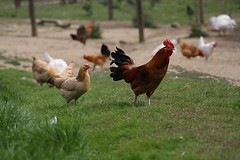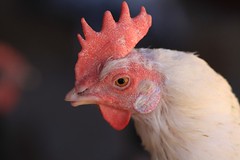The White Leghorn is the #1 breed used to produce eggs in the United States. But this is only partially true. The number 1 breed is not a breed, but a strain within a breed. Hy-Line Hatcheries is the world's largest producer of breeder chickens and chicks for the egg industry. Two of their strains, W-36 and W-98 are the most common strains used to produce white eggs. If you ever buy tinted eggs, it is likely they came from Hy-Line Grey lines. If you buy brown eggs, they probably came from Hy-Line's Brown or from ISA Brown hens (these are sex-linked birds, meaning females are one color and males another, which makes culling male chicks easier).
These are not the only strains. There are other Leghorn strains used to produce eggs and other "brown" strains used to produce brown eggs.
Egg-laying hen strains are great examples of artificial selection affecting behavior in powerful ways.
White Leghorns are known for their flightiness. They are, in my experience, neurotic birds. Part of this stems from their housing. Most Leghorns live in cages so small they cannot spread their wings. 95% of hens in the United States are confined 5-8 birds per cage. Sensory deprivation and intense confinement increase stereotypic/abnormal behaviors and neurosis. But this is not the only reason the most popular strains of Leghorns are so behaviorally strange. Even if you raised Hy-Line W-98 hens from chickhood, there is a good chance that they will grow up to be birds less interested in interacting with you, more likely to be fearful, and more flighty. Part of their neurosis is who they are. I think this is sad. I am not a big fan of breeding animals anyway, but I find breeding neurotic, unhappy, flighty animals to be incredibly unethical
I have experience with two strains of White Leghorn. I do not know what the 1st strain was, but the second were W-98 from a small cage operation. The first strain was comprised of incredibly neurotic birds. They are all 7 years old now and are still neurotic! When they arrived, they were very quiet. It took them 8 months to learn how to perch. Part of that is time needed to develop muscle strength (not moving for two years causes atrophy). Part of that is they did not know how to perch, they just never learned. And part of it, I believe, is because of their genes. The second strain were not just less neurotic, they weighed more and were more aggressive. While the first strain would go immobile when you picked them up, hens from the second strain put up a good fight and, even with beak trims, managed to get a good grip of our hands! They talked in frantic, loud tones. They learned how to perch quite quickly. They were more interested in foraging. But they never, ever showed an interest in being around humans. This they shared with the other strain of white leghorns.
Recently, I experienced first hand the biggest difference between the strains of birds raised for white-egg production and those raised for brown-egg production. (If you care, there are more studies on the difference, but here is one. The White leghorn strain remained far more fearful than the Brown hens.) Forty five hens from a cage-free operation were legally permitted to live and arrived at the sanctuary. They are brown hens. At first I thought they might be ISA Browns, but their combs are too large. I am almost certain they are Hy-Line Commercial Brown. Hy-Line is the #1 producer of egg-laying hens worldwide, so this makes sense.
The commercial brown layers are bigger than Leghorns. They talk more. Normal cooing, very friendly, and if you cared to identify in other terms, sweet-sounding. The biggest difference is their lack of fear around humans. They have never been treated positively by humans, so there isn't any environmental precedent for their fondness toward us bipeds. Their first interaction with humans would have been at a hatchery where their brothers were killed and they were de-beaked. Their next interactions would have involved rough handling and then neutral, partially negative interactions throughout their laying cycle. The final interaction would have been rough handling on their way to the gas chambers and slaughter. And yet they remain inquisitive and egregiously fond of humans. This is part of who they are.
If you ever visit the sanctuary and walk into the poultry enclosure, these hens will be the first to greet you. And if you do what I did today and sit down, this is what will happen. I did not put these hens on my legs, and they were the only birds to perch.

Even the other chickens who are friendly (the speckled sussex to the left is one) do not do this.
And when all the chickens have lost interest and head off to forage or nest, this is who you will be left with:

I am really quite fond of these chickens. They have a great potential to really change visitors minds about chickens. While I do promote a vegan diet, I understand most of the readers of this blog are not vegan. If you insist on eating eggs, I have a few suggestions.
1) Eliminate eggs completely! Okay, okay...
2) Reduce reliance on eggs. We do not need to be eating the amount of eggs we do to survive.
3) Replace store-bought eggs with eggs from pasture-based operations. 99% of all hens are de-beaked. 95% live in cages. Cage-free and free-range are not legally binding terms - their meaning is left up to producers. If you cannot visit a farm, do not buy their products. If you see de-beaked birds, do not buy their products. There are a small number of pasture operations who keep roosters and hens for most, if not all, of their lifespan. If you can find these, good. If not, the next best, in terms of overall animal welfare, are pasture based operations.
4) Commenter Elizabeth pointed out that, if you are zoned for poultry, you can raise your own chickens. My only suggestion would be to adopt, instead of buying. For example, those brown hens? We placed all but 10 (we just had to keep some in our flock) into loving, permanent homes. Shelters often have chickens and farmed animal sanctuaries can often hook you up with people looking to place birds or birds themselves.



1 comment:
You forgot to mention the best alternative!! Have your own chicken coop!! We had a coop when I was younger and they were the best eggs ever...plus the birds were happy. I live in the city right now, but as soon as I buy a house I'm going to have chickens!
Post a Comment